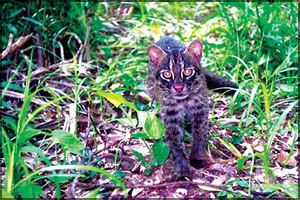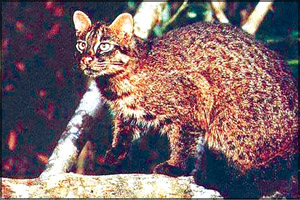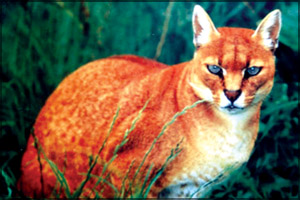
Felines: small, wild and beautiful - x
Four threatened species
Most of you must be amazed at the number of wild cats that live on
our planet, apart from the big cats we are so familiar with. Todate we
have featured more than 20 wild cats and this week we feature four more
of our feline friends. There are many more species, especially the
subspecies to write about.
Chinese mountain cat
|

A rare picture of the cat |
A small wild cat that is also known as the desert cat and the Chinese
grey cat, it is the least known member of the genus Felis. It is endemic
to China and is found at elevations of 3,000 metres (10,000 ft), and
contrary to its name, lives in open country too as its habitats range
from alpine meadows and forests to rocky steppes and mountains.
The Chinese mountain cat is considered to be an endangered species
and is highly protected in China. It is adapted to one of the harshest
climates of the world - extreme winters (below zero) and very hot
summers.
Closely resembling the European wild cat, it sports a light grey
(fawn) coloured coat in winter and a darker coat in summer. It is 69.84
cm (27-33 in) in length with a tail about 29-35 cm (11-14 in) long.
The tail is thick with several dark rings along its length and has a
black tip. It has distinctive short ear tufts similar to a lynx's, but
it is not classed as a lynx. The paw pads are covered in hair in the
same way the sand cat's paw pads are covered. The hair helps the cat to
have a better grip when navigating rugged terrain. Its legs are short.
The males are larger than the females and weigh about 9 kg (20 lbs). The
females weigh about 6.5 kg (14 lbs).
The Chinese mountain cat is known to be a nocturnal (active at night)
animal, but has also been observed to be crepuscular (active during
twilight) in certain areas.
The reproductive season is from January through March. The female
gives birth to 2-4 kittens.
Fact file
Scientific name: Felis bieti
Range: Eastern Tibetian Plateau in Sichuan
Lifespan: 10-12 yers. Many cats die as a result of poisoning from
tainted Pika prey, which is their primary food.
Social structure: Solitary
***
Iriomote cat
|

A living fossil? |
 |
At one time, there was much debate among researchers as to whether
this cat is a subspecies of the leopard cat or a species of its own
because of the great similarities between the two species. Now many are
of the view that they are two separate species and that the Iriomote cat
is closely related to the leopard cat.
No matter what the researchers have decided, the Iriomote cat is one
of the most threatened species of the cat family with fewer than 100
said to exist. Found exclusively in Iriomote situated at the southern
end of the Japanese Ryuku Islands (200 k east of Taiwan), this cat is
considered a 'living fossil' by many biologists. They say the cat has
not changed much from its primitive form. It was discovered in 1967 and
placed in a separate genus as a survivor of an extinct link.
The islanders refer to the cat by various names such as Yamamayaa
(mountain cat), Yamapikaryaa (mountain sparkling eyed) and Pingiimayaa
(escaped cat). Its scientific name is Prionailurus iriomotensis The
Iriomote cat has a coat which is dusky or greyish brown in colour with
dark spots in dense longitudinal rows. They merge into bands. Five to
seven dark stripes run along its neck with two white lines going across
the cheeks, starting from the corner of each eye.
Its tail (16-45 cm) is thick and bushy and the back of the ears are
black with a white central spot. It has an elongated body with short
legs. The cat's overall length is 38-66 cm (15-26 in) and it stands at
25 cm (10 in) at shoulder height. It weighs about 3.7 kg (6.6-15.5 lbs).
The Iriomote is a solitary cat, like most of the other cats, and
hunts both day and night. It is an opportunistic predator and becomes
more nocturnal in the summer than in the winter. During the daytime it
could be seen resting or hiding in tree cavities or rock crevices. An
enthusiastic swimmer, the cat has been observed playing in the water.
Like most of the cat species, the Iriomote too survives on small
mammals, rodents birds and amphibians. Some of its prey include fruit
bats, black rats, wild pigs, night herons, quails, pigeons, crabs and
box turtles. It generally stalks its prey and captures them in a rush.
Iriomotes are known to meow and howl like your pet cat. The female
gives birth to about 2-4 kittens after a gestation period of about 60
days.
***
African golden cat
 |
|

As it lives a reclusive life very little is known about this
cat. |
A medium sized cat found in the rainforests of West and Central
Africa, it is very much similar to the Asian golden cat we featured in
Nature trail in the Junior Observer of February 17. It is also known as
Temminck's cat.
Presently classified as the only member of the genus Profelis, not
much is known of this member of the cat family which lives a secretive
life. It has a head/body length of about 80 cm (31. 5 inches) plus a
tail that reaches 30 cm (about a foot). The shoulder height is about
38-55 cm (1-2 feet). Males are larger and weigh around 11-14 kg (24-31
lbs). These statistics have been obtained from specimens found by
researchers.
Even though it is a good climber, the cat is known to hunt more on
the ground. Its prey include rodents, birds and monkeys.
Like the Iriomote cat, the African golden cat too was originally
classified as two distinct species because of the colour variations of
its coat; the red phase was called the 'Golden' cat and the grey phase
was known as the 'Silver' cat. However, today the two phases are
recognised as one species.
Even though the colour of the coats are primarily red and grey as
mentioned above, African golden cats which are melanistic (all black)
have been observed. The spotted markings are known to vary in these
cats.
The cat is predominantly found in moist forest zones including alpine
bamboo forests and mangroves. It preys on small to mid-sized mammals,
large and small rodents, birds and even small antelope.
There is very little known about its reproduction and offspring
though according to available information, the female is believed to
give birth to one or two kittens weighing about 6.5 - 8 ounces each.
Like many offspring of the cat family, they reach maturity by the time
they are two years of age.
The African golden cat too is threatened by the loss of habitat and
also the depletion of antelope which is part of its diet.
In captivity this cat is known to have lived for 12 years.
***
Jaguarundi
A medium sized wild cat found in Mexico and Central and South
America, this wild cat is closely related to the much larger cousin in
the family - the cougar which is in the genus of puma. It has a
chromosome count of 38 as with the puma and jaguar.
The cat which is classed as an endangered species has four recognised
subspecies. Unlike the other cats, the jaguarundi has a uniform coloured
coat which comes in two phases; blackish - brownish grey (grey phase)
and the foxy red to chestnut colour (red phase).
This colour phases led many a researcher to believe that they are two
different species. In fact the two different coloured cats were given
two different names, the grey phase was known as the jaguarundi and the
red phase, the eyra. However, now it's established that the two phases
are the same species since these two phases have been found in the same
litter.
Found mostly in lowland brush areas close to running water, the
jaguarundi preys on fish, small mammals, reptiles and birds. Averaging a
body length of 65 cm (30 in) with a tail of 45 cm (20 in) the jaguarundi
has short round ears and short leg.
The head is small in proportion to its elongated body and in general,
it has the appearance of a weasel or an otter. Sometimes it is referred
to as the otter cat. Its eyes are narrow and brown in colour.
A good tree climber, the jaguarundi is a highly adaptable animal and
can be found even in dense forests and shrub areas. Even though it is
not hunted for its coat, the animal is endangered due to loss of
habitat.
The female gives birth to a litter of 1-4 kittens after a gestation
period of 70 days. The kittens mature at two years of age. The spots
which are found on their coats at birth disappear as they grow.
Sightings of jaguarundis in the United States have led many people to
wonder if there are black panthers in those areas. But, researchers say
these sightings are of jaguarundis that are mistaken for black panthers. |
